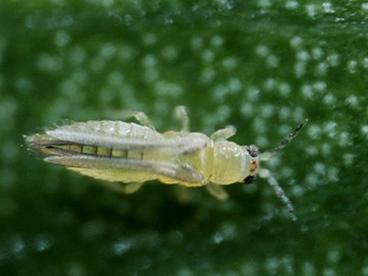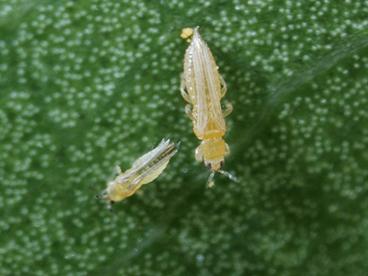From: Chilli Thrips. Baker, J.R. 2019. NC Coop. Ext. Service publication. https://content.ces.ncsu.edu/chilli-thrips
SCIENTIFIC NAME: Scirtothrips dorsalis Hood
CLASS: Insecta
ORDER: Thysanoptera
FAMILY: Thripidae


Description
Adults
Chilli thrips, Scirtothrips dorsalis, are about the size of our native flower thrips (1.2 mm or about 1/16 inch long) but are pale cream rather than amber. This species has dark gray eyes, and the antennae are smokey gray beyond the base. Males are slightly smaller and paler than females. Under a microscope, the most notable characteristic is the fringed or feather-like wings.
Eggs
The egg is cylindrical and kidney-shaped, with a smooth pale or yellow surface.
Larvae
Immature chilli thrips are whitish and resemble adults except for size, lack of wings, and red eyes.
Pupae and Prepupae
Prepupae are pale and have wing buds and antennae that are to the side or front of the head. Pupae are also pale and have longer wing buds and antennae that bend back over the head.
Biology
Distribution
The chilli thrips is an invasive pest from Asia and has been found in Florida and Texas.
Host Plants
Chilli thrips have been reported from hundreds of plant species in at least 40 plant families. They seem to be especially attracted to rose and peppers.
Damage
Their feeding on foliage and flowers causes distortion, scarring, and premature leaf drop.
Life Cycle
The life cycle of chilli thrips is similar to that of other common thrips species, such as the western flower thrips. Egg to adult development is completed within 12 to 22 days, depending on temperature and host plant species. Females insert their eggs inside plant tissue on or near leaf veins, terminal plant parts and floral structures. Eggs hatch in 6–8 days under optimal conditions. Immature thrips pass through two larval stages, with the first instar lasting for 2-4 days and the second instar completing in 3-6 days. Fully-grown larvae molt into a non-feeding, prepupal stage, which may last up to 24 hours, and then pupate on protected plant parts, leaf litter or in the soil near the base of the plant. The pupal stage lasts 2–3 days.